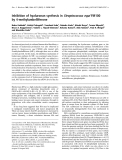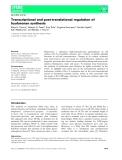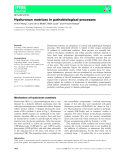
Hyaluronan synthesi
-
As observedpreviously in culturedhuman skinfibroblasts, a decrease of hyaluronan production was also observed in group C Streptococcus equi FM100 cells treated with 4-methylumbelliferone (MU), although there was no effect on their growth. In this study, the inhibition mechanism of hyaluronan synthesis by MU was examined usingStrepto-coccus equiFM100, as a model.
 10p
10p  tumor12
tumor12
 22-04-2013
22-04-2013
 41
41
 2
2
 Download
Download
-
Hyaluronan, a ubiquitous high-molecular-mass glycinoglycan on cell surfaces and in extracellular matrices, has a number of specific signaling functions in cell–cell communication. Changes in its content, molecular mass and turnover rate are crucial for cell proliferation, migration and apoptosis, processes that control tissue remodeling during embryonic devel-opment, inflammation, injury and cancer.
 10p
10p  cosis54
cosis54
 05-01-2013
05-01-2013
 53
53
 5
5
 Download
Download
-
Hyaluronan matrices are ubiquitous in normal and pathological biological processes. This remarkable diversity is related to their unique mechanism of synthesis by hyaluronan synthases. These enzymes are normally acti-vated in the plasma membrane and utilize cytosolic substrates directly to form these large polyanionic glycosaminoglycans, which are extruded directly into the extracellular space.
 7p
7p  cosis54
cosis54
 05-01-2013
05-01-2013
 42
42
 3
3
 Download
Download
CHỦ ĐỀ BẠN MUỐN TÌM
















